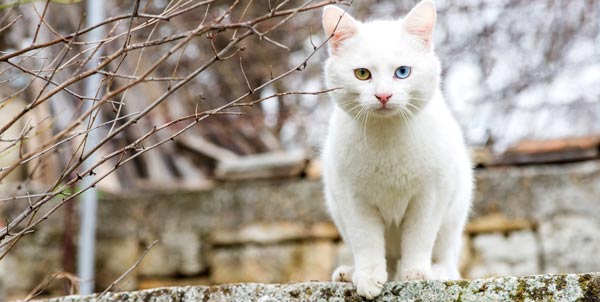White cats: why they suffer from congenital deafness
In white cats, the relationship between coat color and deafness is mainly due to the presence of specific genetic variants.
So, the genetics of white cats influence not only the aesthetic appearance of the animal but are often associated with particular health conditions, including deafness.
Why some cats are white
White in the coat of cats is mainly determined by the presence of a gene known as W (White), which acts as a dominant gene.
This gene inhibits pigmentation throughout the animal’s body.
An interesting feature of this gene is that it not only determines hair color, but also has significant effects on auditory function.
White gene mutation in white cats
In particular, the W gene is responsible for the condition known as congenital deafness, which affects a significant proportion of white cats.
The gene is capable of suppressing melanocytes in the skin and hair, but also in the iris and cochlea or cochlea, which is the part of the inner ear devoted to hearing.
Melanocytes are precisely cells deputed to the transmission of sound.
In addition to deafness, blue eyes, heterochromic irises and deafness also result from melanocyte suppression.
A correlation has been observed between white discoloration and ocular abnormalities, such as microphthalmia, a condition characterized by abnormally small eyes.
However, that not all white cats with blue eyes are deaf, and not all deaf cats have blue eyes, although there is a strong correlation between the two traits.
And again, individuals with the W gene do not necessarily have a solid white coat but may often have patches of color on the head that may fade or disappear altogether with age.
White cats and albino cats: two different conditions
There is a fundamental distinction between white cats and albino cats.
L’albinism is a genetic condition that causes a complete absence of pigmentation in the skin, fur and eyes.
An albino cat has:
- Rosy skin (nose, eyelids, mouth, ears and pads)
- Absence of iris color so eyes appear pink
How to tell if a white cat is deaf
There are several signs that can help identify deafness in one’s feline.
An early indicator of a cat’s possible deafness is in its behavior.
Cats are very sensitive animals to sounds, and if an animal begins to show insensitivity to common noises, it could be a sign of hearing loss.
For example, a cat that does not respond when called or that does not notice familiar sounds such as the rustling of a bag of kibble may have impaired hearing.
In addition, another behavior to be observed is the lack of reaction to sudden sound stimuli and loud noises.
If the cat shows no signs of fear or curiosity when faced with sounds that normally attract its attention, this may be a strong indication of deafness.
Social interactions may reveal additional evidence regarding deafness.
In some cases, deaf cats may develop more aggressive or defensive behaviors because they do not perceive sound communications that elsewhere would give them useful information about their surroundings.
These changes can be interpreted as signs of disorientation.
Dealing with deafness in white cats
Identifying signs of deafness in a cat is not only critical to ensuring the animal’s well-being, but also to improving the overall quality of life.
If you suspect that your cat is deaf, the most recommended thing is to consult your Veterinarian.
The practitioner may perform specific examinations to ascertain the kitty’s hearing health and suggest possible strategies to better manage the situation.
In addition, white cats, and even more so albino cats, are more vulnerable to sunburn.
As a result, they have a high probability of developing squamous cell carcinoma or other forms of skin cancer so they should be protected from sunlight.
To refer your white cat for a checkup and to seek advice on its proper management, contact the veterinary doctors on our staff who are always available to you.
We would also like to remind you that Clinica La Veterinaria is always open h24 every day including holidays and with First Aid service from 8 pm to 8 am.











